
The Sipuncula or Sipunculida is a class containing about 162 species of unsegmented marine annelid worms. Sipuncula was once considered a phylum, but was demoted to a class of Annelida, based on recent molecular work.

The Echiura, or spoon worms, are a small group of marine animals. Once treated as a separate phylum, they are now considered to belong to Annelida. Annelids typically have their bodies divided into segments, but echiurans have secondarily lost their segmentation. The majority of echiurans live in burrows in soft sediment in shallow water, but some live in rock crevices or under boulders, and there are also deep sea forms. More than 230 species have been described. Spoon worms are cylindrical, soft-bodied animals usually possessing a non-retractable proboscis which can be rolled into a scoop-shape to feed. In some species the proboscis is ribbon-like, longer than the trunk and may have a forked tip. Spoon worms vary in size from less than a centimetre in length to more than a metre.
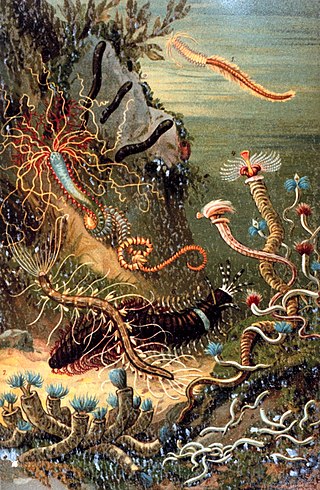
Polychaeta is a paraphyletic class of generally marine annelid worms, commonly called bristle worms or polychaetes. Each body segment has a pair of fleshy protrusions called parapodia that bear many bristles, called chaetae, which are made of chitin. More than 10,000 species are described in this class. Common representatives include the lugworm and the sandworm or clam worm Alitta.
Segmentation in biology is the division of some animal and plant body plans into a linear series of repetitive segments that may or may not be interconnected to each other. This article focuses on the segmentation of animal body plans, specifically using the examples of the taxa Arthropoda, Chordata, and Annelida. These three groups form segments by using a "growth zone" to direct and define the segments. While all three have a generally segmented body plan and use a growth zone, they use different mechanisms for generating this patterning. Even within these groups, different organisms have different mechanisms for segmenting the body. Segmentation of the body plan is important for allowing free movement and development of certain body parts. It also allows for regeneration in specific individuals.
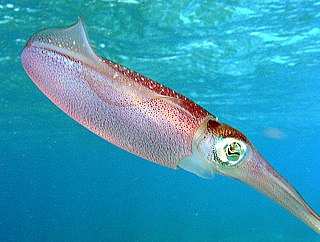
Lophotrochozoa is a clade of protostome animals within the Spiralia. The taxon was established as a monophyletic group based on molecular evidence. The clade includes animals like annelids, molluscs, bryozoans, and brachiopods.
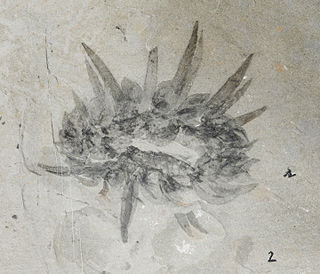
Wiwaxia is a genus of soft-bodied animals that were covered in carbonaceous scales and spines that protected it from predators. Wiwaxia fossils—mainly isolated scales, but sometimes complete, articulated fossils—are known from early Cambrian and middle Cambrian fossil deposits across the globe. The living animal would have measured up to 5 centimetres (2 in) when fully grown, although a range of juvenile specimens are known, the smallest being 2 millimetres (0.08 in) long.
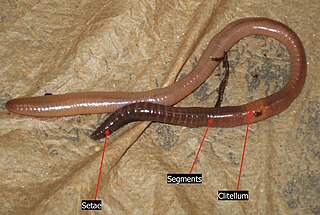
The clitellum is a thickened glandular and non-segmented section of the body wall near the head in earthworms and leeches that secretes a viscid sac in which eggs are stored. It is located near the anterior end of the body, between the fourteenth and seventeenth segments. The number of the segments to where the clitellum begins and the number of segments that make up the clitellum are important for identifying earthworms. In microdrile earthworms, the clitellum has only one layer, resulting in a smaller quantity of eggs than that of the megadrile earthworms, which have larger multi-layered clitellum that have special cells that secrete albumin into the worms' egg sac.
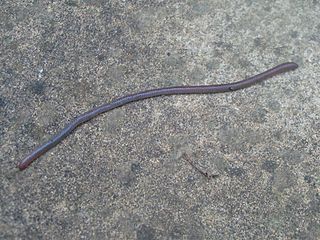
The Haplotaxida are one of two orders within the annelid subclass Oligochaeta, the other being the Lumbriculida. No real common name exists, but they are simply referred to as haplotaxids.

The Clitellata are a class of annelid worms, characterized by having a clitellum – the 'collar' that forms a reproductive cocoon during part of their life cycles. The clitellates comprise around 8,000 species. Unlike the class of Polychaeta, they do not have parapodia and their heads are less developed.

Leeches are segmented parasitic or predatory worms that comprise the subclass Hirudinea within the phylum Annelida. They are closely related to the oligochaetes, which include the earthworm, and like them have soft, muscular segmented bodies that can lengthen and contract. Both groups are hermaphrodites and have a clitellum, but leeches typically differ from the oligochaetes in having suckers at both ends and in having ring markings that do not correspond with their internal segmentation. The body is muscular and relatively solid, and the coelom, the spacious body cavity found in other annelids, is reduced to small channels.

Protostomia is the clade of animals once thought to be characterized by the formation of the organism's mouth before its anus during embryonic development. This nature has since been discovered to be extremely variable among Protostomia's members, although the reverse is typically true of its sister clade, Deuterostomia. Well known examples of protostomes are arthropods, molluscs, annelids, flatworms and nematodes. They are also called schizocoelomates since schizocoely typically occurs in them.
Agamococcidiorida is an order within the subclass Coccidia of the phylum Apicomplexia. All members of this order are parasitic protozoa.

The Spiralia are a morphologically diverse clade of protostome animals, including within their number the molluscs, annelids, platyhelminths and other taxa. The term Spiralia is applied to those phyla that exhibit canonical spiral cleavage, a pattern of early development found in most members of the Lophotrochozoa.

Errantia is a diverse group of marine polychaete worms in the phylum Annelida. Traditionally a subclass of the paraphyletic class Polychaeta, it is currently regarded as a monophyletic group within the larger Pleistoannelida, composed of Errantia and Sedentaria. These worms are found worldwide in marine environments and brackish water.

The annelids, also known as the segmented worms, are a large phylum, with over 22,000 extant species including ragworms, earthworms, and leeches. The species exist in and have adapted to various ecologies – some in marine environments as distinct as tidal zones and hydrothermal vents, others in fresh water, and yet others in moist terrestrial environments.

In annelids, elytra are shield-like scales that are attached dorsally, one pair on each of a number of alternating segments and entirely or partly cover the dorsum. Elytra are modified dorsal cirri, and their number, size, location, and ornamentation are important taxonomic characters. The basal part of the elytra is known as the elytrophore; if elytra are lost their presence is indicated by the elytrophore which is still present and visible.

Enalikter is an extinct arthropod described from the middle Silurian Herefordshire Lagerstätte at the England–Wales border in UK. This genus is known from only one species, E. aphson. Enalikter is described as late-living example of Megacheira, "great-appendage arthropod". It subsequently suggested to be an annelid by other researchers, however subsequent studies rejected this interpretation. Its interpretation as megacheiran arthropod has been questioned in later studies.

Sedentaria is a diverse clade of annelid worms. It is traditionally treated as a subclass of the paraphyletic class Polychaeta, but it is also a monophyletic group uniting several polychaetes and the monophyletic class Clitellata. It is the sister group of Errantia.

Pleistoannelida is a group of annelid worms that comprises the vast majority of the diversity in phylum Annelida. Discovered through phylogenetic analyses, it is the largest clade of annelids, comprised by the last common ancestor of the highly diverse sister groups Errantia and Sedentaria and all the descendants of that ancestor. Most groups in the Clade find their ancestors within the Cambrian explosion when Annelid diversity expanded dramatically. The Pleistoannelida clade covers a variety of traits. However, the evolution of simple to complex eyes, developed papillae for burrowing, and for some specialized radioles for feeding can be seen universally across every species. New findings have discovered the range of Annelid diversity have led to uncertainty if groups with developed ancestral traits should remain within the clade. Furthermore There's been a lack of recently discovered Annelid traits being used in the categorization of groups within the clade, leading to many hypothesis on how to do so and which should remain within the clade. Currently three smaller clades that were originally a part of the groups Errantia and Sedentaria have been proven to fall outside while still being connected to the basal groups.















